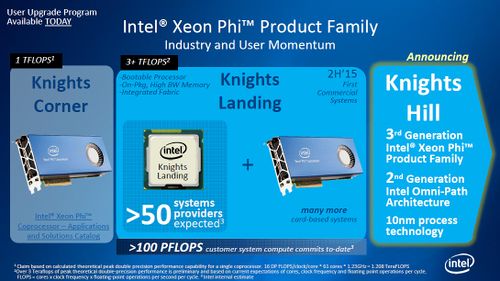From WikiChip
Difference between revisions of "intel/microarchitectures/knights hill"
| (10 intermediate revisions by 2 users not shown) | |||
| Line 6: | Line 6: | ||
|manufacturer=Intel | |manufacturer=Intel | ||
|process=10 nm | |process=10 nm | ||
| + | |type=Superscalar | ||
| + | |oooe=Yes | ||
| + | |speculative=Yes | ||
| + | |renaming=Yes | ||
| + | |isa=x86-16 | ||
| + | |isa 2=x86-32 | ||
| + | |isa 3=x86-64 | ||
|predecessor=Knights Landing | |predecessor=Knights Landing | ||
|predecessor link=intel/microarchitectures/knights_landing | |predecessor link=intel/microarchitectures/knights_landing | ||
| + | |successor=Knights Peak | ||
| + | |successor link=intel/microarchitectures/knights_peak | ||
}} | }} | ||
| − | '''Knights Hill''' was | + | '''Knights Hill''' ('''KNH''') was a planned successor to {{\\|Knights Landing}}, a [[10 nm]] [[many-core]] microarchitecture designed by [[intel]] for high performance computing. |
| + | |||
| + | == History == | ||
| + | [[File:XeonPhiGenerations.jpg|right|500px]] | ||
| + | Announced in 2014, Knights Hill was originally planned to be delivered in 2016 and be manufactured on a [[10 nm process]]. The architecture was also planned to power a number of supercomputers, including the United States highest-performance supercomputer, [[aurora (supercomputer)|Aurora]]. Delays with [[10 nm]] has pushed the product back to 2017. Eventually, in November 2017 Intel announced that Knights Hill would be cancelled: | ||
| + | |||
| + | <blockquote>One step we’re taking is to replace one of the future Intel® Xeon Phi™ processors (code name Knights Hill) with a new platform and new microarchitecture specifically designed for exascale.</blockquote> | ||
| + | |||
| + | == Brands == | ||
| + | Knights Hill was branded as 3rd generation {{intel|Xeon Phi}} | ||
| + | |||
| + | == Process Technology == | ||
| + | Knights Hill was intended to be fabricated on Intel's [[10 nm process]]. | ||
| + | |||
| + | == Architecture == | ||
| + | Intel released very few architectural details regarding Knights Hill. | ||
| + | |||
| + | === Key changes from {{\\|Knights Landing}} === | ||
| + | * [[10 nm]] (from [[14 nm]]) | ||
| + | * 2nd Generation {{intel|Omni-Path|Omni-Path Architecture}} | ||
| + | |||
| + | == References == | ||
| + | * [https://itpeernetwork.intel.com/unleashing-high-performance-computing/ Unleashing High-Performance Computing Today and Tomorrow], November 13, 2017 | ||
Latest revision as of 16:26, 8 April 2018
| Edit Values | |
| Knights Hill µarch | |
| General Info | |
| Arch Type | CPU |
| Designer | Intel |
| Manufacturer | Intel |
| Process | 10 nm |
| Pipeline | |
| Type | Superscalar |
| OoOE | Yes |
| Speculative | Yes |
| Reg Renaming | Yes |
| Instructions | |
| ISA | x86-16, x86-32, x86-64 |
| Succession | |
Knights Hill (KNH) was a planned successor to Knights Landing, a 10 nm many-core microarchitecture designed by intel for high performance computing.
Contents
History[edit]
Announced in 2014, Knights Hill was originally planned to be delivered in 2016 and be manufactured on a 10 nm process. The architecture was also planned to power a number of supercomputers, including the United States highest-performance supercomputer, Aurora. Delays with 10 nm has pushed the product back to 2017. Eventually, in November 2017 Intel announced that Knights Hill would be cancelled:
One step we’re taking is to replace one of the future Intel® Xeon Phi™ processors (code name Knights Hill) with a new platform and new microarchitecture specifically designed for exascale.
Brands[edit]
Knights Hill was branded as 3rd generation Xeon Phi
Process Technology[edit]
Knights Hill was intended to be fabricated on Intel's 10 nm process.
Architecture[edit]
Intel released very few architectural details regarding Knights Hill.
Key changes from Knights Landing[edit]
- 10 nm (from 14 nm)
- 2nd Generation Omni-Path Architecture
References[edit]
- Unleashing High-Performance Computing Today and Tomorrow, November 13, 2017
Facts about "Knights Hill - Microarchitectures - Intel"
| codename | Knights Hill + |
| designer | Intel + |
| full page name | intel/microarchitectures/knights hill + |
| instance of | microarchitecture + |
| instruction set architecture | x86-16 +, x86-32 + and x86-64 + |
| manufacturer | Intel + |
| microarchitecture type | CPU + |
| name | Knights Hill + |
| process | 10 nm (0.01 μm, 1.0e-5 mm) + |
